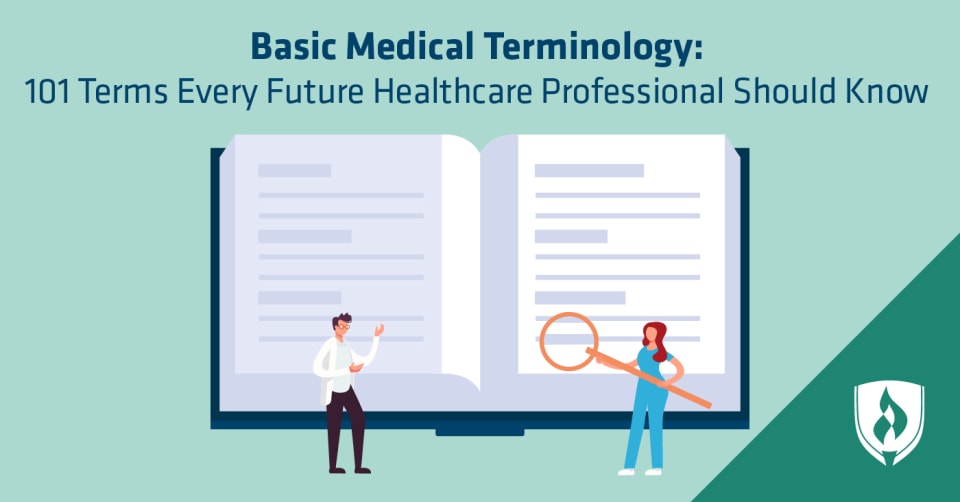Basic Medical Terms: 101 Terms Every Future Healthcare Pro Should Know
By Kirsten Slyter on 06/29/2020

If you’re not familiar with the lingo, medical terminology can leave your head spinning. Whether you’re considering entering the medical field or you’re just trying to navigate the newest medical show, it can be hard to keep up with the at-times alien sounding array of technical terms, abbreviations and jargon that gets used. Even if you have no intention of working in healthcare, it’s good to have a foundation of basics down as it will help you communicate with and understand the healthcare providers you’ll regularly interact with.
While you likely already have the basics down, there’s plenty of room for expanding your knowledge of medical vocabulary—and you’re in the right place. We’ve rounded up a substantial list of common medical and healthcare terms and have provided simple-to-understand definitions to get you started.
Medical terms for patient status
- Acute: Patient with a sudden flare-up or potentially severe issue who needs immediate care.
- Critical: Patient’s vital signs are out of the normal range and patient may be unconscious.
- Inpatient: Status of a patient who requires hospital admission.
- Observation: A temporary status that allows patients to continue receiving care for a set amount of time in the hospital while the physician determines whether admission or discharge is best.
- Outpatient: Status of a patient who is not admitted to a hospital for overnight care. This can include clinic visits, same-day surgeries, and one-day emergency room visits.
Medical terms for conditions and diseases
- Abrasion: A scrape that typically only affects the skin and can usually be treated at home.
- Abscess: A tender, pus-filled pocket usually due to infection.
- Acute: Signifies a condition that begins abruptly and is sometimes severe, but usually short.
- Aneurysm: A bulge in the wall of an artery that weakens the artery and can lead to rupture.
- Aortic dissection: A tear in the inner layer of the aorta.
- Bradycardia: A slowing of the heart rate—typically less than 60 beats per minute for adults.
- Benign: Usually in reference to tumors or growth, meaning not cancerous or malignant.
- Biopsy: A small sample of tissue that’s taken for testing to discover the cause or extent of a disease.
- Chronic: Signifies a recurring, persistent condition, usually more than three months.
- Contusion: A bruise typically from impact or force.
- Cyanosis: Condition resulting bluish skin, stems from lack of oxygen in the blood.
- Diagnosis: Identification of a condition, disease or disorder by evaluation of symptoms, tests and other factors.
- Thrombosis: A blood clot within a blood vessel that affects normal blood flow.
- Edema: Swelling caused by fluid accumulation.
- Embolus: A blood clot, air bubble or other obstruction blocking blood flow in the affected blood vessel.
- Fracture: Broken bone ranging from a crack to a complete break.
- Atrial fibrillation: An uncoordinated, quivering movement of the heart muscle resulting in an irregular pulse and poor blood flow.
- Hypertension: Abnormally high blood pressure.
- Hypotension: Abnormally low blood pressure.
- Ischemia: Characterized by a lack of blood flow to an organ or part of the body. Often refers to the heart-cardiac ischemia.
- Malignant: In reference to tumors or growths—indicating the presence of cancerous cells.
- Cancer: Collection of related diseases where some of the body’s cells multiply out of control spreading into surrounding tissues and interfering with normal body function.
- Normal sinus rhythm: A normal heartbeat pattern, usually is between 60 and 80 beats per minute in an adult.
- Tumor: A swelling or mass, often used in relation to cancer.
- Tension pneumothorax: A collapsed lung that occurs when air leaks into the space between the lungs and the chest wall.
- Pericardial effusion: Blood or fluid leaking into the pericardium, the sac surrounding the heart.
- Myocardial infarction: When an arterial blockage or slow blood flow deprives the heart of blood. Known more commonly as a heart attack.
- Angina: A disease in which narrowing of the arteries supplying the heart results in reduced blood flow and chest pain. Usually a symptom of coronary artery disease.
- Cerebrovascular Accident (CVA): Commonly called a stroke. Occurs when the brain is deprived of blood and oxygen by either a blockage or the rupture of a blood vessel.
- Sepsis: A serious condition caused the body’s response to severe infection. Occurs when the body’s infection-fighting response gets out of balance and can lead to severe issues like organ failure.
Tools and equipment, and medication terms
- Endoscope: A long flexible tube with its own special lighting and camera used to look into the body. There are many specific kinds of endoscopes.
- Foley: An indwelling catheter. A thin flexible tube inserted into the urethra to drain the bladder.
- Fluoroscope: An X-ray machine—can be used for still images or in motion, like an animation created by x-ray images.
- Stethoscope: A small instrument used for listening to a patient’s breathing and heartbeat.
- Intravenous (IV): Indicates medication or fluid given through the vein.
- Epidural: An injection of a local anesthetic to the lumbar level of the spin often used to relieve pain during labor.
- Sublingual: Meaning “below the tongue,” typically seen with medication that is administered by dissolving it under the patients’ tongue.
- Nocte: Latin for at night, typically in reference to when medication should be administered.
- Mane: Latin for in the morning, typically in reference to when medication should be administered.
- OD: When referring to medication instructions, “once daily.”
- BDS : Latin, “bis die sumendum” meaning take two times per day.
- TDS: Latin, “ter die sumendum” meaning take three times per day.
- QDS: Latin, “quarter die sumendum” meaning take 4 times per day.
- PRN: Latin, “pro re nata” or take as needed.
- PR: Latin, “per rectum” to be taken rectally.
- PO: Latin, “per orem” to be taken by mouth or orally.
- IV push: A direct, rapid injection of medication delivered intravenously.
- NS: Normal saline—a mixture of salt and water similar to what’s produced by the body.
Medical jargon/slang
- Champagne tap: A successful lumbar puncture done by a student with no red blood cells found. Traditionally this challenging procedure is celebrated with a bottle of champagne from a supervising doctor—in part because the fluid collected resembles the color of champagne.
- Stat: Immediately
- Thready: Refers to a weak pulse that disappears with pressure—an indicator of larger issues.
- Golden hour: Refers to the first hour after a traumatic injury or event where chances of successful treatment are highest.
Medical procedures and tests
- Blood culture: A test used to find any unusual bacteria or fungi in a patient’s blood.
- Blood gas: A test to show the gas-phase components of blood including oxygen, carbon dioxide, pH balance, etc.
- Blood pressure: Measure of how well the blood is circulating. Normal blood pressure measure about 120/80 for adults.
- Blood swab: A blood sample taken with a cotton-tipped stick.
- Bowel disimpaction: Manual removal of hardened fecal matter from a patient's rectum.
- Central line: Catheter placed in a large vein that allows multiple IV fluids to be given and blood to be drawn more easily.
- C-section: Shorthand for cesarean section the surgical delivery of a baby through the abdominal wall.
- Puls/ox: Pulse oximetry, a measure of oxygen saturation in blood.
- Dialysis: Procedure to filter blood for patients with kidney failure.
- Pulse: Measure of a pulsating artery.
- Intubation: Insertion of an endotracheal tube to assist patient breathing.
- Laparotomy: Any surgery involving an incision in the abdominal wall.
- Lumbar puncture: Withdrawal of cerebrospinal fluid through a hollow needle inserted into the lumbar region. Also referred to as a spinal tap.
- Sternotomy: Surgical opening of the breast bone.
- Thoracotomy: Surgery on the chest cavity.
- Tox screen: Toxicological analysis of the blood. Ordered when a drug overdose is suspected and the drugs need to be identified.
- Ultrasound: A form of diagnostic imaging that uses high-frequency sound waves.
- Venipuncture: The drawing of blood from a vein.
Abbreviations
- ALOC: Acute Loss of Consciousness
- ASA: The abbreviation for acetylsalicylic acid, commonly known as aspirin.
- BMI: Body mass index, a measure of body fat based on height and weight.
- BP: Blood pressure.
- BLS: Basic life support includes CPR and removal of foreign body airway obstruction.
- CAT scan: Computerized axial tomography—another form of diagnostic imaging.
- CHF: Congestive heart failure.
- CPR: Cardiopulmonary resuscitation, a life-saving technique that’s also called mouth-to-mouth resuscitation.
- DNR: Do not resuscitate. A medical order indicating providers should not perform CPR or other life-saving measures on a patient.
- DOA: Dead on arrival.
- ED/ER: Emergency department or emergency room.
- EEG: Measures brain activity.
- EKG/ECG: Electrocardiogram. Records the electrical signals in the heart.
- EMS: Emergency medical services.
- HR: Heart rate, expressed as beats per minute.
- KUB: Kidney, ureter, and bladder x-ray, commonly used for diagnosing abdominal pain.
- LFT: Liver function test.
- MRI: Magnetic resonance imaging, a form of diagnostic imaging that uses a large magnet and radio waves to view organs inside of the body.
- NICU: Neonatal intensive care unit, a specialized unit for premature infants.
- NSAID: Nonsteroidal anti-inflammatory drug (ibuprofen, aspirin, naproxen).
- OR: Operating room where surgeries are performed.
- OT: Occupational therapy.
- Psych: Refers to psychiatry practice or the psychiatric ward.
- PT: Physical therapy—rehabilitative exercises used to rebuild strength and flexibility after injury.
- Rx: Shorthand for prescription, usually for medication but can also signify another treatment.
- U/A: Urinalysis–the process of testing patient urine for signs of kidney failure, dehydration, diabetes, undernourishment, or bladder, kidney infection and more.
Looking to take the next step toward a healthcare career?
Whew! Feeling a little more informed now that you’ve made it through this list of basic medical terms? That’s great, but the truth is that there’s a lot more to learn if you have your sights set on a healthcare career. If you’d like to learn more about some of the options you have for getting started sooner than later, check out our article, “Exploring 12 Healthcare Jobs You Can Launch in 2 Years or Less.”




